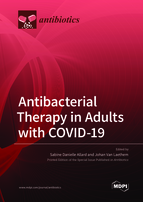Antibacterial Therapy in Adults with COVID-19
A special issue of Antibiotics (ISSN 2079-6382). This special issue belongs to the section "Antibiotic Therapy in Infectious Diseases".
Deadline for manuscript submissions: closed (30 November 2022) | Viewed by 29672
Special Issue Editors
Interests: HIV immunology; SARS-CoV-2 immunology; mRNA vaccines; antimicrobial stewardship; COVID-19
Interests: antimicrobial stewardship; multi-drug resistant infections; antibiotics; diagnostic stewardship
Special Issue Information
Dear Colleagues,
Since the emergence of the Coronavirus-19 infectious disease (COVID-19) pandemic, a rising number of reports have underlined the risk of increasing antimicrobial resistance due to antibiotic overuse in COVID-19 patients. In addition, many physicians and pharmacists involved in antimicrobial stewardship have had to shift their activities to the containment of the COVID-19 crisis. In contrast to this observed overconsumption of antibiotics, very few bacterial superinfections have been documented in COVID-19 patients, especially in patients admitted outside the intensive care unit and in the first days of admission. However, identification of bacterial co-/superinfections in COVID-19 patients is difficult, as inflammatory and radiological markers of bacterial infection lack specificity in this setting. Furthermore, studies regarding the effect of immune suppression, including the use of corticosteroids and anti-interleukins, and the effect of potential immunomodulatory properties of certain antibiotics on the occurrence of bacterial co-/superinfection are needed.
This Special Issue of Antibiotics seeks the submission of manuscripts aiming to increase our knowledge regarding (more or less specific) markers associated with bacterial co-/superinfection in COVID-19 patients, quantitative and qualitative data regarding antibiotic prescriptions in COVID-19 patients, potential beneficial effects of antibiotic use in certain COVID-19 subgroups, detrimental effects associated with antibiotic overuse in COVID-19 patients, and evidence-based guidelines which could facilitate the decision process when antibiotic prescriptions are considered.
Prof. Dr. Sabine Danielle Allard
Dr. Johan Van Laethem
Guest Editors
Manuscript Submission Information
Manuscripts should be submitted online at www.mdpi.com by registering and logging in to this website. Once you are registered, click here to go to the submission form. Manuscripts can be submitted until the deadline. All submissions that pass pre-check are peer-reviewed. Accepted papers will be published continuously in the journal (as soon as accepted) and will be listed together on the special issue website. Research articles, review articles as well as short communications are invited. For planned papers, a title and short abstract (about 100 words) can be sent to the Editorial Office for announcement on this website.
Submitted manuscripts should not have been published previously, nor be under consideration for publication elsewhere (except conference proceedings papers). All manuscripts are thoroughly refereed through a single-blind peer-review process. A guide for authors and other relevant information for submission of manuscripts is available on the Instructions for Authors page. Antibiotics is an international peer-reviewed open access monthly journal published by MDPI.
Please visit the Instructions for Authors page before submitting a manuscript. The Article Processing Charge (APC) for publication in this open access journal is 2900 CHF (Swiss Francs). Submitted papers should be well formatted and use good English. Authors may use MDPI's English editing service prior to publication or during author revisions.
Keywords
- antibiotics
- antimicrobial stewardship
- Sars-CoV-2
- COVID 19
- antimicrobial resistance
- bacterial co-infection
- bacterial superinfection







